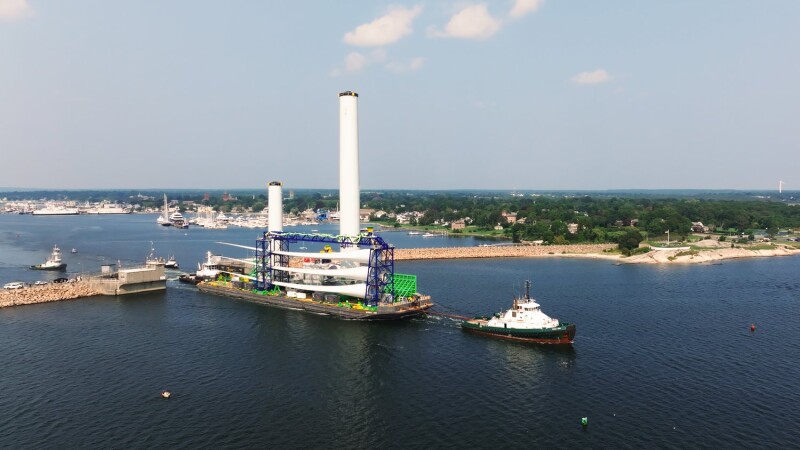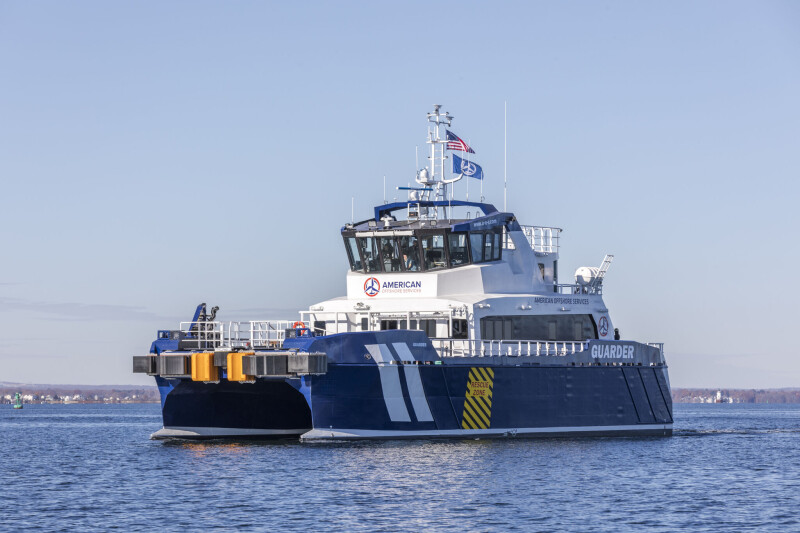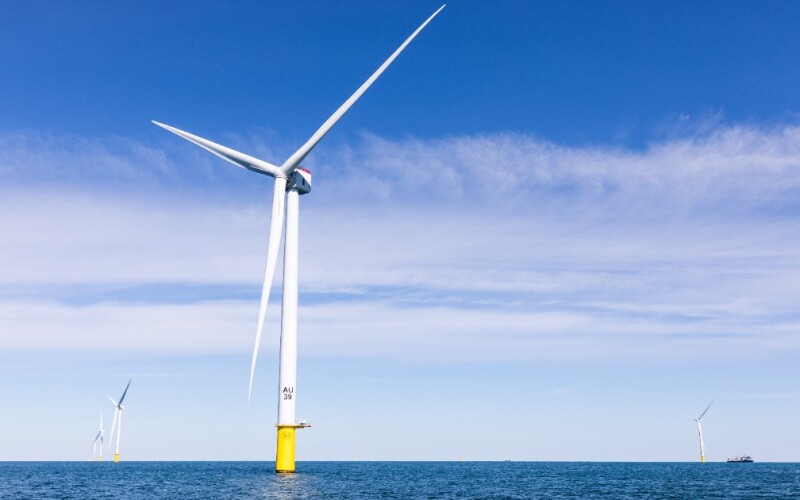Facing the existential threat of a new Trump administration, offshore wind power advocates are mounting their own post-election campaign to win critical support from Republican and Democratic lawmakers and governors.
President-elect Donald Trump’s campaign promise to make sure offshore wind development “ends on day one” of his new administration has cast a pall over the fledgling U.S. wind industry – raising the prospect of the incoming administration cutting off environmental and construction permits and blocking any future offshore wind lease sales by the Bureau of Offshore Energy Management (BOEM).
Wind industry advocates are scrambling to make their case that offshore wind is good for Trump’s stated goals of rebuilding U.S. industry and jobs. Since 2016, wind power companies have invested in purpose-built, U.S.-flagged vessels and have helped promote the use of hybrid power over traditional diesel propulsion – a shift that is being adopted by ferry and passenger vessel operators too.
Pitching U.S. offshore wind power as a bipartisan success story, Liz Burdock, president and CEO of the industry group Oceantic Network, credits Trump’s first administration for helping to get the industry off the ground.
“When President-elect Donald Trump takes office, he will re-inherit an industry he kickstarted. Eight years ago, the first Trump administration began implementing the fundamental framework for our modern offshore wind industry and oversaw three federal lease sales that netted $456 million for the federal treasury,” Burdock wrote in the Nov. 22 issue of Recharge.
“Those actions led to the first wave of investments in supply chain facilities for the industry, which are now creating jobs in places like Texas and South Carolina and enabled the substantial level of investment we’ve seen since 2020,” wrote Burdock.
Anticipating opposition from the impending Trump presidency, offshore wind developer TotalEnergies SE, said Nov. 26 it is suspending work on its Attentive Energy project planned off New York and New Jersey.
The 3,000-megawatt array south of New York Harbor could be operational in the 2030s, according to developers. Nonetheless, “I have decided to put the project on pause” with Trump’s return, Patrick Pouyanne, CEO of the France-based TotalEnergies multinational, said at an energy industry conference in London, Bloomberg reported.
The Attentive Energy project is still in the early stages of permitting with BOEM, although developers have obtained offshore leasing rights from the federal agency. Pouyanne indicated TotalEnergies may wait for political winds to shift again.
“I said to my team, the project in New York, we’ll see that in four years,” he said, Bloomberg reported. “But the advantage is it’s only for four years.”
Although wind power was supported early in Trump’s first administration, his top Department of Interior officials turned sharply against the industry in the last months of 2020, trying to cancel permits for the Vineyard Wind project off southern New England.
In early 2021, President Biden’s new administration swiftly restarted Vineyard Wind permitting. A new Trump administration can upend the process again, by blocking permits and new lease sales.
The move by TotalEnergies could foreshadow difficult decisions by other offshore wind companies – and for domestic U.S. companies who have mobilized to provide the supply chain to offshore wind power. Despite Trump’s change of heart, existing leases, long lead times for permitting and growing demand for power give the wind industry hope to outlast opposition.
Burdock stresses how many U.S. companies are already deeply invested: “Our message to policymakers is clear: the U.S. offshore wind industry has become an economic powerhouse,” she said. “It’s driving local and state economies and positioning the U.S. as an energy leader. It has the potential to accelerate this progress and even enhance our national security by diversifying our energy sources and increasing domestic energy production.

“It would also advance the incoming administration’s goals, supporting the domestic production of steel and shipyard expansion while rebuilding our nation’s port infrastructure.”
OPPONENTS NOT STOPPING
New Jersey opponents of offshore wind projects, including commercial fishermen, seaside homeowners, and tourism interests, are heartened by Trump’s electoral win. Trump made his pledge to end wind projects at a May campaign rally on the beach at Wildwood, N.J., before a crowd that included many local activists.
“The national election results may portend a change in federal policy regarding offshore wind projects,” the opposition group Save Long Beach Island wrote on its social media page a day after the Nov. 5 election. “However, the wind company for the project off LBI has stated its intention to proceed under prior federal approvals if it receives approval from the state… Save LBI remains committed to fight the construction of the country’s largest offshore wind project just 8 miles from our pristine shore. There will be no letting up in our efforts in this battle.”
New Jersey’s Democratic Gov. Phil Murphy, who made renewable energy and offshore wind a central policy of his administration, is fighting to maintain support. The state energy plan took a major blow in fall 2023 with developer Ørsted’s sudden decision to cancel its Ocean Wind 1 project in the face of escalating costs.
In a Nov. 13 interview with Newark, N.J. radio station WBGO, Murphy insisted renewable energy will boost the economy and criticized Trump and Republican efforts to make offshore wind another front in the political culture wars.
“It’s gotten this ‘woke’ label, which is ridiculous,” said Murphy.
New Jersey’s official goal of 100% renewable energy by 2035 far surpasses a 2006 study that envisioned a pilot project of up to 80 turbines using then-available designs around 400’ tall – compared with current plans by Atlantic Shores, a venture by Shell New Energies and EDF, to build up to 195 turbines more than 1,000’ tall off Long Beach Island. Environmental groups, wanting to move away from fossil fuels, supported the state’s planning from the beginning. But even then, activists focused on New Jersey coastal waters were more skeptical, as were fishermen, fearing future conflicts.
“Even if the site isn’t that important to us, it could have an impact on commercial fishing. It might be clam beds, it might be scallop beds, it might be grounds where the flounder guys drag,” Tony Bogan, a party fishing boat captain and president of the industry group United Boatmen of NJ/NY, told the Asbury Park Press in May 2006.

HYBRID POWER ADVANCES WITH WIND
Regardless of how the political battle unfolds for future wind projects, developers with established leases and construction plans are driving activity – and innovation – among designers and shipbuilders supplying the new wind energy fleet.
In late 2024, American Offshore Services (A-O-S), Providence, R.I., took delivery of the newbuild crew transfer vessel (CTV) Guarder from shipbuilder Blount Boats, Warren, R.I.
Blount was an early entrant in the U.S. CTV market, in 2016 delivering the Atlantic Pioneer, a 70’6”x24’x4’ aluminum catamaran and the first U.S-flagged CTV. A-O-S’s Guarder is a 98’ Jones Act-compliant aluminum catamaran purpose-built to transfer technicians and equipment in support of the offshore wind industry on the U.S. East Coast. It has capacity to accommodate 24 passengers.
The newbuild is the third G-class series CTV delivered to A-O-S, a partnership between Swedish CTV operator Northern Offshore Services (N-O-S) and U.S.-based investment firm Orion Infrastructure Capital (OIC).
A-O-S’ G-class vessels are being built according to ABS and U.S. Coast Guard standards. Each features quad Volvo Penta IPS propulsion. Guarder is “hybrid-ready”, meaning it has been built with extra space on board to enable a conversion to hybrid power in the future.

“We have taken delivery of three vessels in three quarters. The industry is growing and the demand for CTVs is steady,” said Michael Burbelo, managing director at A-O-S. “As I said earlier this year, we are just getting started.”
Meanwhile, across Narragansett Bay, Senesco Marine, North Kingstown, R.I., launched a new Jones Act-compliant CTV for its sister company, WindServe Marine. The new vessel, WindServe Spartan, is servicing the emerging offshore wind industry on the U.S. East Coast. Both Senesco Marine and WindServe Marine operate under the Reinauer Group.
The delivery of the WindServe Spartan marks the final boat of a six-vessel contract that Senesco has with WindServe. The aluminum catamaran was designed by naval architects BMT, Houston, and measures 95’x30’ with a 5’6” draft.
Compared with the first four CTVs, the WindServe Spartan has an extended engine control room (ECR) to allow for hybrid-ready capabilities.
Ted Williams, Senesco’s president, spoke about the 6’ ECR extension, which was also incorporated into WindServe’s fifth delivered vessel, WindServe Frontier.
“We’re not supplying the hybrid system at this time, but in the event a customer in the future wants that, there’s enough room in the back of the engine room to go hybrid if there’s the desire to do that,” Williams said.
On the West Coast, new moves toward hybrid low-emission transport include Washington State Ferries’(WSF) announcement on Oct. 3 that three shipbuilders have expressed interest in constructing five 160’x53’x7.5’ hybrid-electric ferries. The selected shipbuilders include Nichols Brothers Boat Builders, Freeland, Wash., Eastern Shipbuilding Group, Panama City, Fla., and Philly Shipyard, Philadelphia.
WSF invited shipbuilders nationwide to submit pre-qualification packages, a move made possible by 2023 state legislation enabling the agency’s capacity to source shipbuilding talent across the country and build vessels at multiple sites concurrently.
The planned ferries will each accommodate 160 vehicles and are expected to enhance services on the Mukilteo-Clinton and Seattle-Bremerton routes. The first two vessels are anticipated to be completed by 2028, with an additional two by 2029 and the final vessel by 2030.
The WSF hybrid-electric ferries are part of WSF’s $3.98 billion Ferry System Electrification plan. The plan aims to reduce greenhouse gas emissions by 76% by 2040 and achieve zero emissions by 2050.
This article was featured in our January issue. Want to share your insights or contribute to our next edition? Reach out today to executive editor Eric Haun at [email protected].




